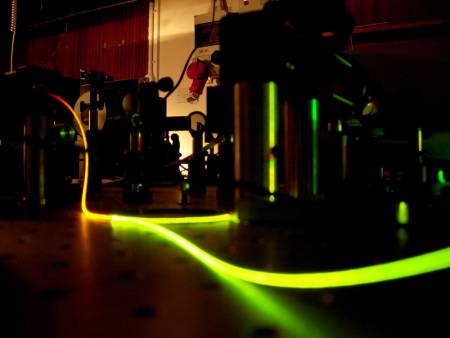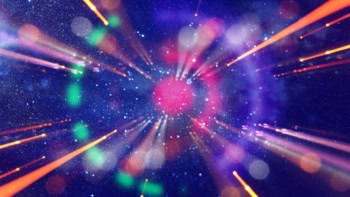
Everyone knows the score with black holes: even if light strays too close, the immense gravity will drag it inside, never to be seen again. They are thought to be created when large stars finally spend all their fuel and collapse. It might come as a surprise, therefore, to find that physicists in the UK have now managed to create an “artificial” black hole in the lab.
Originally, theorists studying black holes focused almost exclusively on applying Einstein’s theory of general relativity, which describes how the gravity of massive objects arises from the curvature of space–time. Then, in 1974, the Cambridge University physicist Stephen Hawking, building on the work of Jacob Bekenstein, showed that quantum mechanics should also be thrown into the mix.
Hawking suggested that the point of no return surrounding a black hole beyond which light cannot escape — the so-called event horizon — should itself emit particles such as neutrinos or photons. In quantum mechanics, Heisenberg’s uncertainty principle allows such particles to spring out of the empty vacuum in pairs all the time, although they usually annihilate shortly after. But if two particles were to crop up on either side of a black hole’s event horizon, the one on the inside would be trapped while the one on the outside could break free. To an observer, the black hole would look like a thermal body, and these particles would be the black hole’s “Hawking radiation”.
This is all very well in theory, but in practice Hawking radiation from a black hole would be too low to be detected above the noisy cosmic microwave background (CMB) left over from the Big Bang. Simply put, black holes are too cold. Even the smallest black holes, which according to Hawking should have the warmest characteristic temperature, would still be about eight orders of magnitude colder than the CMB.
Faced with the difficulty of observing Hawking radiation from astrophysical black holes, some physicists have attempted to make artificial ones in the lab that have a higher characteristic temperature. Clearly, generating huge amounts of gravity is both dangerous and next to impossible. But artificial black holes could be based on an analogous system in which the curved space–time of a gravitational field is enacted by another varying parameter that affects the propagation of a wave. “We cannot change the laws of gravity at our will,” Ulf Leonhardt at the University of St Andrews in the UK tells physicsworld.com. “But we can change analogous parameters in a condensed-matter system.” Leonhardt’s group at St Andrews is the first to create an artificial black-hole system in which Hawking radiation could be detected (Science 319 1367).
We cannot change the laws of gravity at our will Ulf Leonhardt, University of St Andrews
Fishy physics
The idea of using analogous systems to create black holes was first proposed by William Unruh of the University of British Columbia in 1981. He imagined fish trying to swim upstream away from a waterfall, which represents a black hole. Beyond a certain point close to the waterfall, the current becomes so strong — like an event horizon — that fish cannot swim fast enough to escape. In the same vein, Unruh then considered what would happen to waves flowing from the sea into a river mouth. Because the current gets stronger farther up a river, the waves can only progress so far upstream before being defeated. In this way, the river is a “white hole”: nothing can enter.
In the St Andrews experiment, which uses the refractive index of a fibre optic as the analogy for a gravitational field, there are actually both black and white holes. It relies on the fact that the speed of light of light in a medium is determined not only by the light’s wavelength, but also by the refractive index.
The group begins by sending a pulse of light through an optical fibre that, as a result of a phenomenon known as the Kerr effect, alters the local refractive index. A split-second later they send a “probe” beam of light, which has a wavelength long enough to travel faster through the fibre and catch up the pulse. But due to the altered refractive index around the pulse, the probe light is always slowed enough to prevent it from overtaking — so the pulse appears as a white hole. Likewise, if the group were to send the probe light from the opposite end of the fibre, it would reach the pulse but would not be able to go through to the other side — so the pulse would appear as a black hole.
What are the minimal properties required to induce Hawking radiation in a lab system the way we think it is induced by gravitational black holes? Renaud Parentani, University Paris-Sud
Over the event horizon
Leonhardt and his colleagues proved that these black- and white-hole event horizons exist by monitoring the group velocity of the probe light, which never exceeded that of the pulse. More importantly, they have calculated that it should be possible to detect Hawking-radiation particles produced at either of the event horizons by filtering out the rest of the light at the far end of the fibre.
The detection of Hawking radiation would help physicists bridge the gap between quantum mechanics and general relativity, two presently incompatible theories. It might also help physicists investigate the mystery surrounding the wavelength of photons emitted at an event horizon, which is thought to start at practically zero before being stretched almost infinitely via gravity.
However, Renaud Parentani of University Paris-Sud in France thinks that, although it may be possible to glimpse radiation from an event horizon in future versions of the group’s system, the radiation might not possess all the expected properties of Hawking radiation generated by astrophysical black holes. For instance, the fibre-optic system is limited by dispersion, which means that the wavelength of photons produced at the event horizon will not be stretched very far. “What are the minimal properties required to induce Hawking radiation in a lab system the way we think it is induced by gravitational black holes?” he asks. “The answer, even on the theoretical side, isn’t clear. But these experiments will encourage us to consider the question more deeply.”



